George Miller
Dickens Characters
and Scenes on Tuck Oilettes
IN ADDITION TO the four sets of “Kyd” lithographs, Raphael Tuck and Sons published 18 sets of Oilettes depicting the characters and countryside of Charles Dickens.
Three sets of six (3406, 3407, and 9852) reproduce the splendid paintings by Harold Copping and 12 sets of six (“In Dickens Land” — 6012, 6046, 6047, 6048, 6049, 6050, 6051, 6052, 7057, 7058, 7059, and 7060) show the drawings of the very famous Dickens illustrator, “Phiz” (Hablot Knight Browne).
The Copping cards bear the full signature and the majority of the “Phiz” cards carry either the scrawled pseudonym or the line “After the picture by ‘Phiz’, despite the fact that all were originally published as illustrations to the various novels and stories before appearing on cards. There are, in addition, three sets (“In Dickens Land”—1163, 1164, and 1350) which portray scenes from the novels, of Gadshill (Dickens’ home), or English views associated with Dickens. One other set in the Tuck Aquarette series (6271) shows scenes from Rochester which figured in the novels. This is signed S. Aveling.
All the “Phiz” cards yet seen are divided back, although there are several postmarked in both England and the U.S. in 1905. The 1163 and 1164 sets appear with both undivided and divided backs; our earliest postmark here is April 1904. (There are striking differences here between the undivided and divided back cards: in one case, the Old Curiosity Shop appears as a horizontal view in the undivided back 1163 set, yet when reissued as a divided back card the negative was cropped differently to produce a vertical card. Our earliest postmark on set 1350 is also 1904, despite the divided back.
Some of the Copping paintings appeared on Tuck’s Dickens calendars as early as 1908 although the books containing them were not published until the 1920s and 1930s. Most of the Copping cards bear the Arms of the Prince of Wales, indicating that they were printed sometime between 1911 and 1936. Various backs testify to numerous reprintings.
The Copping illustrations lend themselves particularly well to the Oilette process; all are rich in color and robust in conception and execution. As opposed to the “Kyd” drawings, which depict single characters, the Copping pictures generally portray an episode from one of the novels and provide a rich gallery of life and dress in nineteenth-century England.
Harold Copping was born in 1863 and died in 1932. In 1911 Tuck published Children’s Stories from Dickens containing illustrations by Harold Copping and Frances Brundage. His illustrations to A Christmas Carol appeared in 1920, and in 1924 Tuck published character sketches from Dickens containing some of the Copping pictures which appear on the Oilette cards.
Harold Copping illustrated other Dickens calendars published by Tuck in 1906 through 1911. Some contained high quality prints, suitable for framing and sold for six shillings.
In addition to Dickens, Copping also illustrated Shakespeare and such other works as Little Women and Pilgrim’s Progress. He was, however, undoubtably best known as a Dickens illustrator. The “Dickensian” in 1907 endorsed Harold Copping as “one of the very best delineators of Dickens’ characters amongst modern artists” and added that “all his pictures show how thoroughly he understands the spirit of the novelist’s humor and pathos.”
If biographical information on “Kyd” and Harold Copping is scarce, such certainly is not the case for “Phiz.” Hablot Knight Browne (born 1815, died 1882) was selected by Dickens himself to illustrate the novels from his own “verbal descriptions.” Their association continued from The Posthumous Papers of the Pickwick Club in 1837 through A Tale of Two Cities in 1859. Tuck apparently simply obtained the rights to reproduce some of these drawings on cards. Although these sets certainly appeared as early as 1905 with the regular Oilette back, some of the sets were reprinted for the Dickens Centenary in 1912 and bear a special imprint on the back. In some instances, the coloring of the regular Oilettes and the Dickens Centenary cards is quite different although the designs are the same. The “Phiz” illustrations, originally black and white engravings etched on steel plates, were apparently colored for their appearance on the Tuck cards. They are sharply delineated sketches with a heightened sense of caricature.
Many collectors have the “Phiz” sets in original wrappers indicating that they were sold as souvenirs of the Old Curiosity Shop in London. Despite the fact that the “Phiz” and Copping illustrations were not originally commissioned for postcards, they are certainly among the very finest and most interesting sets published by Raphael Tuck.
CHECK LIST OF TUCK DICKENS OILETTES
SIGNED HAROLD COPPING
(V = vertical format, H = horizontal * = example card included)
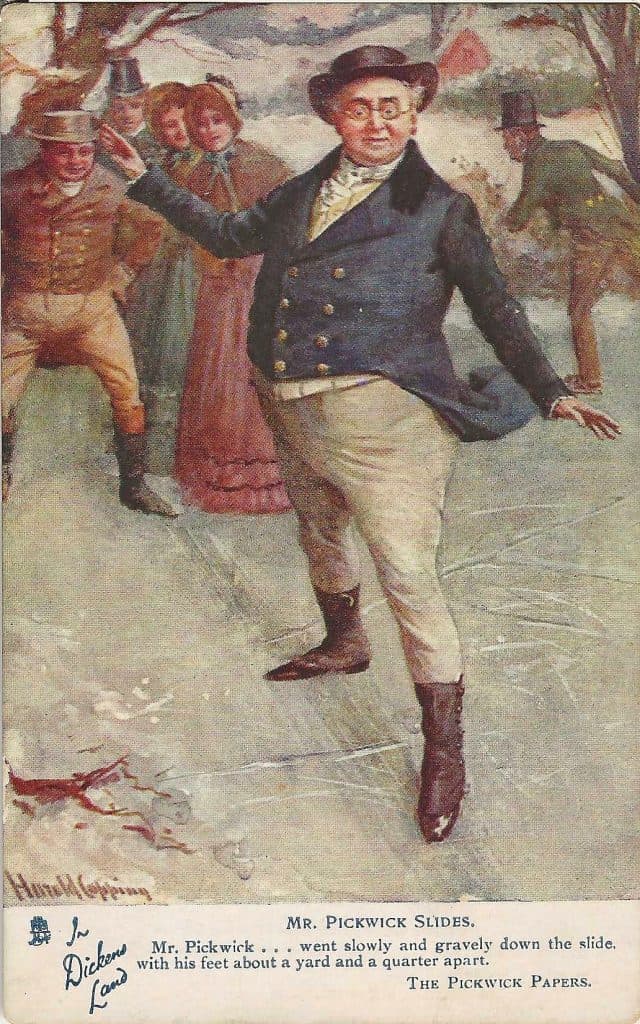
Series 3406
Mr. Squeers and a New Pupil – V
David Copperfield and Little Bn’ly – V
David Copperfield and the Friendly Waiter – V
David Copperfield and Uriah Heep – V
David Copperfield with Barkis on the road to Yarmouth – V
David Copperfield and Mr. Micawber – V
Series 3407
Little Nell and her Grandfather – V
Oliver Twist and Mr. Bumble – V
Sam Weller and his Father – V
Mr. Pickwick in the Pound – V
How Scrooge kept Christmas Day – V
Mr. Pickwick addresses the Club – V
Series 9852
*Mr. Pickwick Slides – V
Mr. Peggotty and Little Em’ly – V
Mr. Micawber Makes Punch – V
Bob Cratchit’s Christmas Dinner – V
Oliver Twist Asks for More – V
Trotty Veck and His Daughter Meg – V
CHECK LIST OF TUCK OILETTES “IN DICKENS LAND”
SIGNED “PHIZ”
Series 6012 – THE PICKWICK PAPERS
“Damages, gentlemen — heavy damages” – V
“Wot I like in that ‘ere style of writin” – V
“Mr. Tupman, we are abserved!” – V
“He would not deny” – V
“I never met with anything so awful” – V
Mr. Pickwick was struck motionless – V
Series 6046 – THE PICKWICK PAPERS
“Here he is!” – V
In one instant the mottled-faced gentleman – H
“Eh?” said Jingle – H
At this point of his discourse – V
The horse … drew Mr. Winkle – V
There was a fine gentle wind – V

Series 6047 – DAVID COPPERFIELD
“What a world of gammon and spinnage it is”- V
“You are the Mr. Murdstone” – V
All was over in a moment – V
“Just draw me a glass” – V
*”I’ll drink it, if you like” – V
Walking so proudly – V
Series 6048 – DAVID COPPERFIELD
“My aunt sitting on a quantity of luggage” – H
“I was aware of a strange presence” – H
“Now, welcome poverty!” – H
“It was Mr. Micawber, with his eyeglass” – H
*”You don’t feel like me” – H
“There was another thing I could have wished” H

Series 6049 – DAVID COPPERFIELD
Miss Betsy looking round the room – V
“Well, sir, if you can make out” – H
I could speak no more – H
Masr, Davy, he said in a low
The best wish I could give
She was singing in a low tone
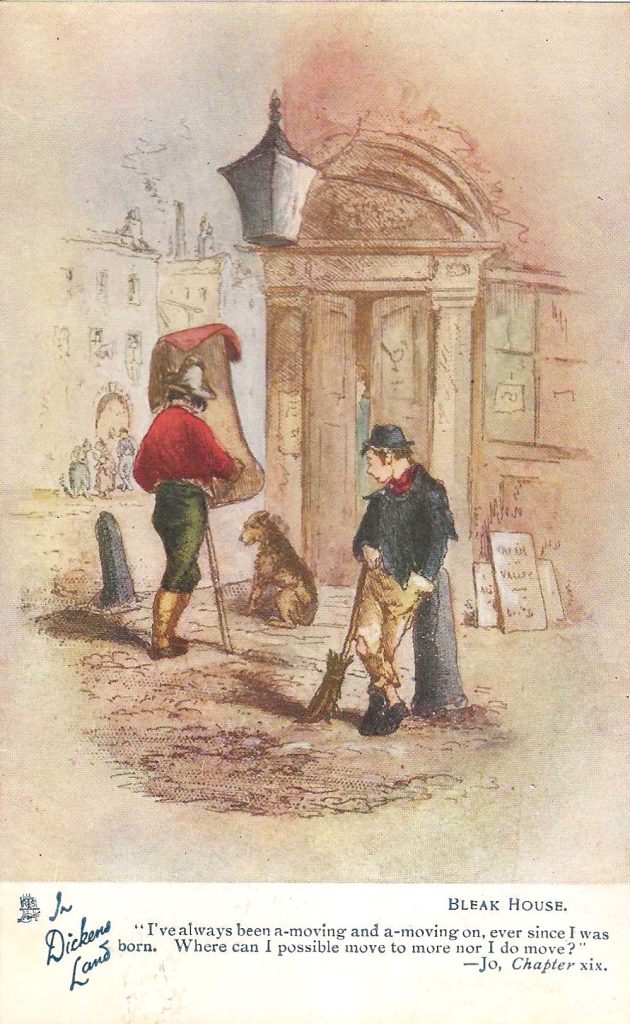
Series 6050 – DOMBEY AND SON
Her overcharged young heart – V
Captain Cuttie was labouring – V
“O, Cap’en Cuttie, Cap’en Cuttie” – V
Paul had the honour of being taken – V
Coming full into the sphere – V
“My name’s Jack Bunsby” – V
Series 6051 – BLEAK HOUSE
Prince Turveydrop . . . never rested – H
“My son!” said Mr. Turveydrop – H
*”I’ve always been a-moving” – V
The young man of the name of Guppy – H
Here you see me utterly incapable” -V
“We have here among us” – H
Series 6052 – NICHOLAS NICKLEBY
“Consider Kate!” cried Nicholas – V
“It’s our custom’, sometimes, to tell” – V
She was forced into a kneeling posture
“False. Oh dem! Now my soul” – V
Concentrating into that one moment – V
Series 7057 – MARTIN CHUZZLEWIT
Such a busy little woman – V
“Oh! confound your honour” – V
“You may bestride my senseless corse,
“Why, he’s gone,” cried Tom – V
“Betsey,” said Mrs. Gamp – V
One glance at the resolute face – V
Series 7058 – MARTIN CHUZZLEWIT
“I have completed my arrangements” – V
*And even while the guard – V
“Occasionally we had the presumption” – V
Mr. Jonas produced a dirty pack – H
“I’m a coming out strong at last” – V
No intrusion, Mr. Pinch
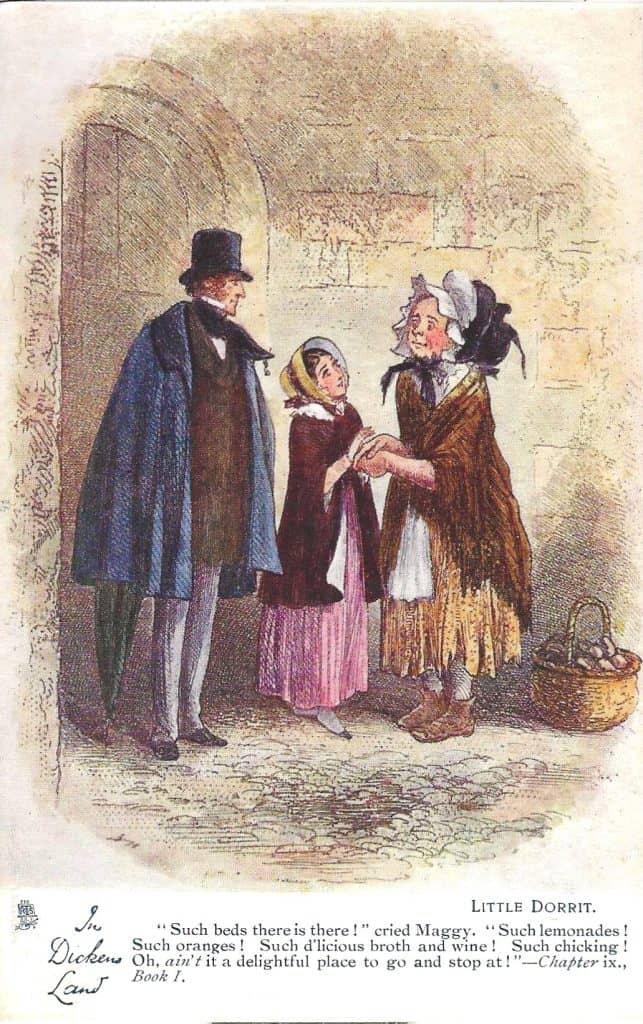
Series 7059 – LITTLE DORRITT
She sat so long – V
*”Such beds there is” – V
“Affery, my woman” – H
Mrs. Plormish’s father was
None of your eyes at me
You are very obedient
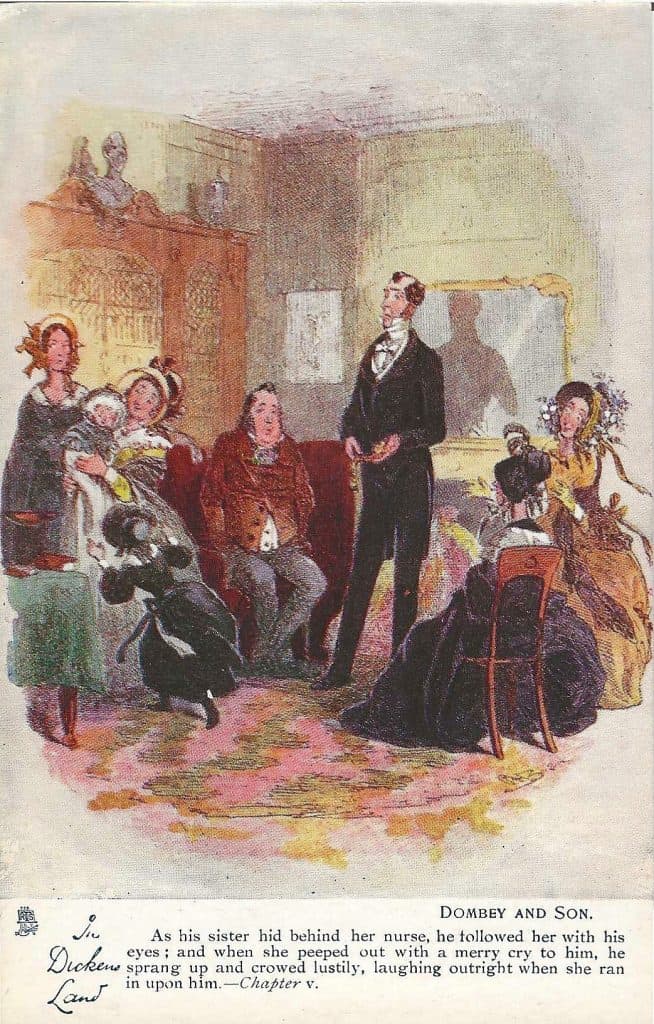
Series 7060 – DOMBEY AND SON
*As his sister hid behind nurse – V
The cat, Paul, and Mrs. Pipchin – V
“Just another!” said Mr. Toots – V
The expatriated native – V
“All you’ve got to do” – V
Florence sat down at night – V
CHECK LIST OF SCENIC “IN DICKENS LAND” OILETTES
Series 1163
Chas. Dickens House, Gadshill – H
Charles Dickens’ Study, Gadshill – H
The “Little Inn,” Canterbury – V
Dotheboys Hall – H
Maidstone – H
The Old Curiosity Shop – V
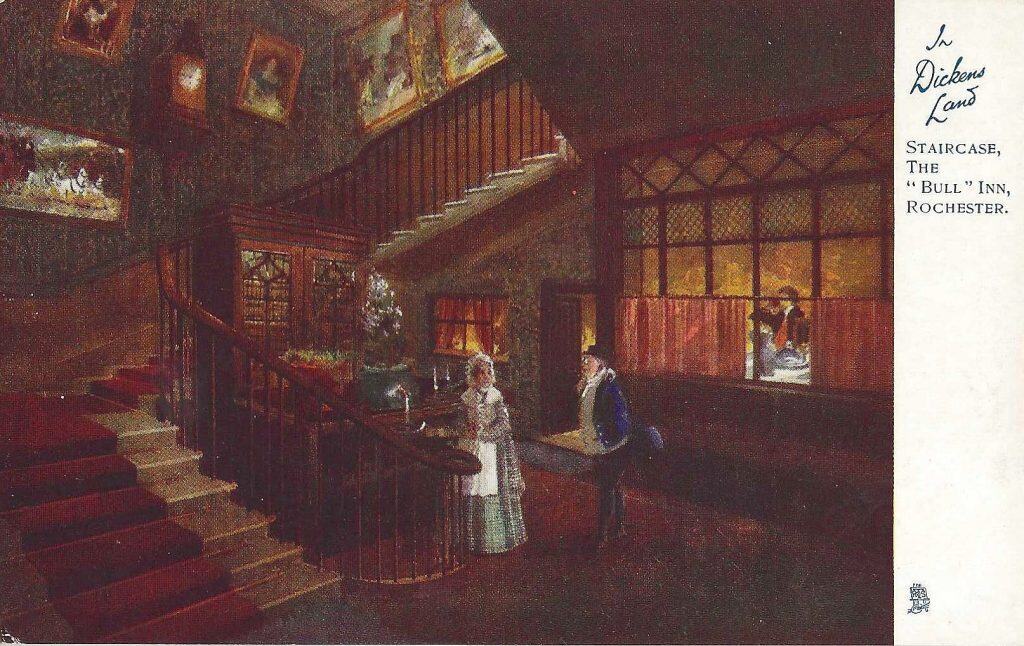
Series 1164
Mr. Pickwick’s Adventure – H
Gateway, Lincoln’s Inn – V
The “Leather Bottle,” Cobham – V “
The Bull” Inn, Rochester – V
*Staircase, Bull Inn, Rochester – H
Courtyard, “Bull” Inn, Rochester – V
Series 1350
Oliver Twist Arrives in London – V
Bleak House, Broadstairs – H
Marsh Lock, Henley – H
Aylesford – V
Rochester from Strood Pier – H
The White Hart, Hook, Surrey – H
Series 6271
“The Restoration House,” Rochester – H
Eastgate House, Rochester – H
Rochester Castle. The Keep – H
Rochester Castle. The Interior – V
West Door, Rochester Cathedral – V
Cobham Hall, Kent – V
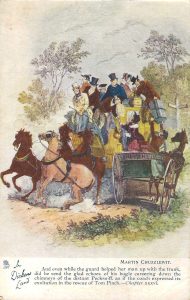
I remember reading Dombey and Son for a college English course over forty years ago.
I have gingerly stepped into the Tuck collecting world now and then but it’s so vast that it’s hard to know where to begin or what to look for. This is a great article. For a moment, I was wondering why there wasn’t the obligatory shout-out to TuckDB but of course it was written well before any such thing existed, or could even have been imagined!
What quaint sets of wonderful cards! I haven’t read Dickens for such a long time. It seems almost like a different language to puzzle our. Thanks for the pictorial education too.